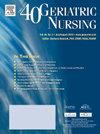Trajectory changes and temporal priorities between depressive symptoms and social participation: A longitudinal study
IF 2.5
3区 医学
Q3 GERIATRICS & GERONTOLOGY
引用次数: 0
Abstract
Background
Depressive symptoms and social participation are important factors influencing the health of older persons. Further research is needed to understand the interaction between these two variables.
Method
The Center for Epidemiological Studies Depression Scale (CES-D) and the Social Participation Questionnaire were employed to assess depressive symptoms and social participation. A latent growth model (LGM) was used to investigate changes in the trajectories of variables. The parallel process latent growth model (PP-LGM) and autoregressive cross-lagged model (ARCL) determined whether correlations existed.
Result
Older persons' depressive symptoms worsened while their level of social participation decreased. The intercept of depressive symptoms was negatively correlated with the slope of social participation(r=-0.133, p = 0.011). The slope of depressive symptoms and social participation were positively correlated(r = 0.444, p < 0.001). Depressive symptoms at earlier time points predicted later social participation(β1=-0.025, p1=0.032, β2=-0.040, p2=0.001).
Conclusion
There are dynamic changes and correlations between depressive symptoms and social participation in older persons.
求助全文
约1分钟内获得全文
求助全文
来源期刊

Geriatric Nursing
医学-护理
CiteScore
3.80
自引率
7.40%
发文量
257
审稿时长
>12 weeks
期刊介绍:
Geriatric Nursing is a comprehensive source for clinical information and management advice relating to the care of older adults. The journal''s peer-reviewed articles report the latest developments in the management of acute and chronic disorders and provide practical advice on care of older adults across the long term continuum. Geriatric Nursing addresses current issues related to drugs, advance directives, staff development and management, legal issues, client and caregiver education, infection control, and other topics. The journal is written specifically for nurses and nurse practitioners who work with older adults in any care setting.
 求助内容:
求助内容: 应助结果提醒方式:
应助结果提醒方式:


